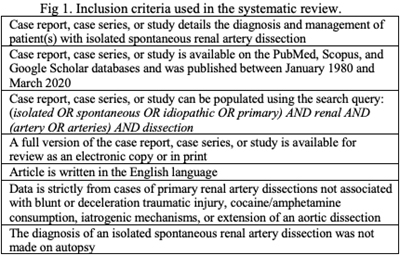Isolated Spontaneous Renal Artery Dissection: A Systematic Review And Pooled Analysis Of Two Hundred Seventy Patients In The Contemporary Medical Literature
Steven Tohmasi, BS, Nii-Kabu Kabutey, MD, William Q. Duong, MD, George E. Kopchok, BS, Carlos E. Donayre, MD, Isabella J. Kuo, MD, Roy M. Fujitani, MD.
University of California, Irvine Medical Center, Orange, CA, USA.
OBJECTIVES: Isolated spontaneous renal artery dissection (ISRAD) is an extremely rare cause of severe hypertension and renal infarction. Given its rarity, there is currently no consensus on the optimal treatment strategy for this condition. Our goal was to perform an analysis of the existing clinical, treatment, and outcome data on ISRAD.
METHODS: A systematic review was conducted of the published English-language literature on ISRAD in the PubMed, Scopus, and Google Scholar databases from January 1980 to March 2020. 627 abstracts were screened, with 105 selected for full-text review. Of these, 81 case reports, case series, and retrospective studies met the inclusion criteria listed in Figure 1. Demographic, clinical, diagnostic, treatment, and outcome data were collected, pooled, and analyzed.
RESULTS: Pooling of the data from the literature revealed 270 patients (224 males) with 318 ISRADs in total. The mean age was 44.3 years. 134 (50%) were managed using antihypertensive, analgesic, anticoagulation, and/or antiplatelet medications. 128 (96%) of these patients had preserved renal function and controlled blood pressure (BP) at the time of last follow up (range, 0-23 years). No patient required renal replacement therapy (RRT). There were 2 (1%) cases of mortality. 136 (50%) patients underwent open or endovascular surgery for persistent symptoms, uncontrollable hypertension, and/or deteriorating renal function. 68 patients underwent 59 open arterial reconstructions and 19 primary partial or total nephrectomies. 7 (12%) attempted open arterial reconstructions failed. 68 patients had endovascular therapy performed, most commonly stent implantation (82%). Dissection-related mortality occurred in 3 patients (4%), due to dissecting aneurysm rupture in all cases, and RRT was required in 1 (1%) patient. Embolization was performed in all 4 cases. The technical success rate of stent implantation was 97% (57/59 ISRADs). After stent implantation, 52 (93%) of 56 patients had improved BP control and 54 (96%) had preserved renal function at the time of last follow up (range, 0-14 years).
CONCLUSIONS: Nonoperative, medical management is a reasonable and safe primary therapy in most patients with ISRAD. Open or endovascular surgery may be considered as adjunctive measures to preserve renal function or control refractory renovascular hypertension, when feasible.
Back to 2021 ePosters
